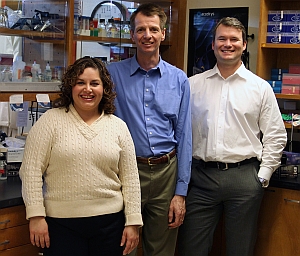
L-R: Rubi Figueroa-Teran, Claus Tittiger, and Dan Langford (Mike Wolterbeek, University of Nevada, Reno)
Biochemical researchers at University of Nevada in Reno started a company making compounds to control forest pests, based on their research in insect enzymes. Rubi Figueroa-Teran and Claus Tittiger, in Reno’s College of Agriculture and Biotechnology, started the company EscaZyme Biochemicals and were invited to join National Science Foundation’s Innovation Corps (I-Corps) to get the company off the ground.
Figueroa-Teran, a postdoctoral research in Tittiger’s lab, studied the production of pheromone enzymes by bark beetles, a tiny insect that destroys millions of acres in forests in American western states. Tittiger has studied bark beetles since the 1990s, and has been interested in the development of a technology to regulate beetle populations without harming the host trees.
Figuero-Teran and Tittiger examined the process by which bark beetles produce pheromones that they use for aggregation and mating. Pheromones enable bark beetles to metabolize toxic resins, and thus thrive under the bark of host trees, where they do their damage. Figuero-Teran’s doctoral dissertation investigated enzymes involved in pheromone biosynthesis and detoxification that led to a simpler and more natural process of producing pheromone chemicals than used in industry today.
The researchers got help from the university’s technology transfer office in developing their research idea into a business idea. “We realized one enzyme could be really useful for pest control,”says Tittiger. “Pheromone chemicals smell nice, like sweet pine. They are used by pest-control companies to create lure-traps.” Pheromones also are used in making fragrances.
Reno’s technology transfer experts helped Figuero-Teran and Tittiger sort through product possibilities, with help from a Reno MBA student and retired chemical company executive, as well as gauge the market for various products, and estimate customer needs, market volumes, and costs. At this stage, the team could begin devising a business strategy.
At first, for example, Figuero-Teran and Tittiger thought their enzymes would be used to lure bark beetles away from trees, but in their inquiries they discovered forest managers were not interested in just moving bark beetles someplace else. The foresters wanted the beetles dead. This discovery led to a tangible product idea: funnel traps that lured bark beetles with the pheromone chemicals. Inquiries from other biochemical companies about their process provided evidence they were on to something.
The researchers got help in crystalizing their ideas from taking part in National Science Foundation’s I-Corps training sessions in October 2012 for academic scientists making the transition to entrepreneurs, with 24 other university teams. They were joined in the I-Corps training by Dan Langford of Reno’s technology transfer office, who specializes in industry partnerships. The group also got a $50,000 I-Corps grant from NSF.
As a result of the training, Figuero-Teran and Tittiger founded EscaZyme Biochemicals to take their biochemicals to market. They also hired Jennifer Ott as the company’s CEO. Ott has an undergraduate degree in chemistry and is finishing her MBA at Reno.
Read more:
- NSF Adding Three I-Corps University Innovation Centers
- Janssen R&D Opens Lab Space to Individual Entrepreneurs
- Wake Forest Health Expands Commercialization Program
- U.K. Devotes £60 Million for Science Entrepreneurship
- Life Sciences Can Generate Start-Ups, With a Little Help
* * *

 RSS - Posts
RSS - Posts
[…] Research on Insects Leads to Forestry Biochemical Start-Up […]